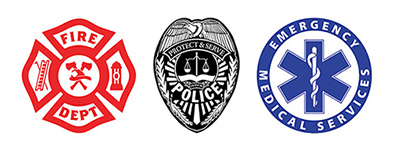
| |
| Home |
| 2025 Memorial Sites |
| Registration |
| Rider List |
| RULES and FAQs |
| Additional Rides |
| TOH Store |
| Archived Memorials |
| WELCOME! Banners |
| Donate |
| Contact Us |
First Responders |
 |
34 U.S. Code § 10705 The term “first responder” includes a firefighter, law enforcement officer, paramedic, emergency medical technician, or other individual (including an employee of a legally organized and recognized volunteer organization, whether compensated or not), who, in the course of his or her professional duties, responds to fire, medical, hazardous material, or other similar emergencies. The Tour of Honor Ride to Remember annually honors our nation's heroes and their families who paid the ultimate sacrifice. This year, during the 15th consecutive year of the self-guided, self-paced nationwide Tour through all fifty states, the Tour of Honor will honor First Responders -- the men and women who bravely rush to the scene to help those in need. In each state, the Tour of Honor annually selects up to seven memorials to honor our heroes and in 2025 up to five memorials per state will feature memorials and monuments to First Responders. Some special dates to remember to honor these heroes while you ride: Sunday, May 4, 2025: International Firefighters DaySunday, May 11 through Saturday May 17, 2025: National Police Week Saturday, May 17, 2025: Armed Services Day Sunday, May 18 through Saturday, May 24, 2025: National EMS Week Tuesday, July 8, 2025: International Paramedics Day Thursday, September 11, 2025: 9-1-1 Emergency Number Day Wednesday, October 8, 2025: National Emergency Nurse'sDay Wednesday, October 28, 2025: National First Responders Day The term First Responder originally appeared in the Oxford English Dictionary in the early 1970s. But even though the term has only been popularized over the past half century, the concept and work of a First Responder has been around for millennia. The Greek inventor and mathematician, Ctesibuis, who lived in ancient Alexandria, Ptolemaic Egypt, during the third century BC, invented the the first pumper firetruck to support the bucket brigades which already existed. Soon after that, the Roman Emperor, Gaius Julius Caesar Augustus, also known as Octavian, established an organized fire department for the city of Rome. Augustus' "Vigiles" were both the public firefighting and policing forces. Ambulance services also date back to the times of the Roman armies. Before the Roman Empire, soldiers wounded on the battlefield were mostly left where fallen. Once the battle was over, searches for survivors took place. The Roman army is credited with the concept of soldiers in battle carrying their wounded fellow comrades to the rear for medical treatment even as the battle raged. Archaeological evidence further suggests that around 900AD a hammock-based cart constructed by the Anglo-Saxons was in operation as the earliest of ambulances. The Normans improved the concept by suspending a litter between two horses. During the 1487 Siege of Málaga, wheeled carts were first used to transport the injured. No medical care was included. It was Napoleon's Chief Physician Dominique Jean Larrey who is credited for adapting the wheeled horse-drawn artillery vehicles to be able to put wheels under litters, presumably carrying medical supplies out to the injured for battlefield triage while wheeling the wounded back for better care. As America grew, so did the need for First Responders. As that need grew, so did the need to be able to quickly alert First Responders to the pending emergency. In 1957 America, the National Association of Fire Chiefs recommended a single number for calling in and reporting fires. It was a decade later when the President Johnson's Commission on Law Enforcement and Administration of Justice determined that one single number should be agreed upon nationwide for reporting any and all emergency situations. This idea mirrored the national emergency telephone number in the United Kingdom, 9-9-9, which had been in operation since 1937, and a similar system in Winnipeg, Manitoba, Canada, since 1959. A year later, in 1968, AT&T announced it would establish the number 9-1-1 as the emergency contact number within its rotary-dial telephone system of subscribers. Other phone companies slowly joined in. National agreement of the 9-1-1 idea was almost immediate and approximately 97% of the geographic US is covered today. The first 9-1-1 call in America was dialed on February 16, 1968, by Senator Rankin Fite in Haleyville, Alabama. The second 9-1-1 system call was placed six days later in Nome, Alaska. Today's systems are advancing to permit instantaneous identification of the caller's location, with 'E911', as well as 'text to 911' which allows callers to send silent text messages for help. Being a First Responder is not for the faint of heart. Every day, they face challenges of mind, body, and spirit. First Responders are some of this nation's most dedicated and true heroes, and often willing to sacrifice everything in service of others. In 2014, singer-songwriter Matt Jackson produced an anthem to honor these heroes, Thank You First Responders. God save the one -- by Rider and State Sponsor Joe Yarzebinski
|
|
|||




